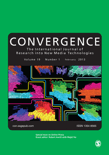
Convergence-The International Journal of Research into New Media Technologies
Scope & Guideline
Pioneering Research at the Nexus of Communication and Technology
Introduction
Aims and Scopes
- Digital Media and Society:
The journal investigates the socio-cultural implications of digital media, analyzing how platforms shape user behavior, identity, and community formation. - Technological Impact on Culture:
Research often addresses how emerging technologies, such as AI, virtual reality, and social media, influence cultural production, consumption, and representation. - Political Dimensions of New Media:
The journal explores the role of digital technologies in political mobilization, activism, and the dynamics of power within online spaces. - Fandom and Community Formation:
A consistent theme is the study of fandoms and online communities, examining how they cultivate shared identities and practices in a digital context. - Critical Media Studies:
The journal promotes critical analysis of media practices, focusing on ethics, representation, and the implications of media convergence. - Interdisciplinary Approaches:
Emphasizing interdisciplinary methodologies, the journal integrates perspectives from sociology, cultural studies, communication, and technology studies.
Trending and Emerging
- Impact of AI and Machine Learning:
There is a growing trend towards investigating how AI and machine learning technologies affect content creation, curation, and user interactions within digital spaces. - Digital Activism and Resistance:
Recent publications highlight the role of social media in facilitating activism, with a focus on how marginalized communities utilize digital platforms for resistance. - Mental Health and Digital Wellbeing:
Emerging studies explore the implications of digital media on mental health, highlighting issues like addiction, digital fatigue, and the impact of social media on self-esteem. - Intersectionality in Digital Spaces:
A notable increase in research examining intersectional identities and experiences within digital contexts, addressing race, gender, and sexuality. - Immersive and Interactive Media Experiences:
The journal is increasingly featuring research on immersive technologies such as virtual reality and augmented reality, analyzing their cultural and social implications. - Platform Studies:
An emerging focus on the specificities of different digital platforms, their governance, and how they shape user behavior and cultural practices.
Declining or Waning
- Traditional Media Critique:
There has been a noticeable decline in papers focusing solely on traditional media forms (e.g., television, print) as the journal shifts towards more digitally-centric analyses. - Static Representations of Identity:
Research that examines identity in a static or singular framework is becoming less prevalent, as newer studies emphasize fluidity and intersectionality in digital identities. - Nostalgia for Past Media Forms:
Themes centered around nostalgia for past media (e.g., retro gaming, vintage television) are less common, indicating a shift towards contemporary and futuristic media analyses. - Isolated Case Studies:
The journal is moving away from isolated case studies of specific media phenomena, favoring broader theoretical frameworks and comparative analyses across multiple platforms. - Crisis of Representation:
Research discussing crises of representation in a narrow context is declining, as more studies now adopt a broader view of representation across diverse media.
Similar Journals
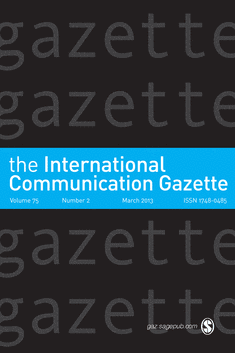
International Communication Gazette
Navigating the Complexities of Global DiscourseThe International Communication Gazette is a prestigious academic journal published by SAGE Publications Inc. that has been at the forefront of communication studies since its inception in 1961. With a focus on interdisciplinary research, this journal aims to explore the ever-evolving landscape of communication within the contexts of sociology and political science. Ranking in the top quartile (Q1) in both the Communication and Sociology & Political Science fields, it offers significant insights into current trends and theories, making it a vital resource for researchers, professionals, and students alike. The journal holds a commendable position in Scopus rankings, standing at #82 out of 511 in Communication and #245 out of 1466 in Sociology and Political Science, reflecting its impact and relevance in the scholarly community. Although it is not an open-access journal, the International Communication Gazette remains committed to disseminating high-quality, peer-reviewed research that sparks discussions and furthers understanding in the dynamic world of global communication.
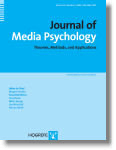
Journal of Media Psychology-Theories Methods and Applications
Advancing Insights in Media Psychology.Journal of Media Psychology: Theories, Methods and Applications, published by HOGREFE PUBLISHING CORP, is a distinguished journal dedicated to exploring the intricate relations between media and psychological processes. With an ISSN of 1864-1105 and E-ISSN 2151-2388, this journal serves as an essential platform for researchers and professionals in the fields of Applied Psychology, Communication, and Social Psychology, evidenced by its impressive category quartiles ranking of Q3 and Q2 respectively in 2023. The journal’s broad scope encompasses various methodologies and theoretical frameworks, aimed at facilitating dialogue and innovation in media psychology, making significant contributions to both academic and practical applications. Recognized for its influence, it ranks within the top 73rd percentile in the Communication category according to Scopus, solidifying its reputation as a vital resource for advancing knowledge and understanding in this rapidly evolving field. Researchers and students will benefit from its rigorous peer-reviewed articles that inform both scholarly discourse and practical endeavors without Open Access barriers, ensuring accessibility to insightful research that shapes the future of media psychology.
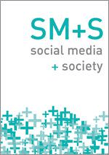
Social Media + Society
Bridging Research and Society Through Open Access InsightsSocial Media + Society is a premier, open access journal published by SAGE Publications Ltd, dedicated to the interdisciplinary exploration of social media's impact on society. Since its inception in 2015, this journal has rapidly established itself as a leading platform for scholarly discourse, evidenced by its impressive Q1 rankings across multiple categories, including Communication, Computer Science Applications, and Cultural Studies, as of 2023. With a Scopus ranking placing it in the top percentiles of its field, Social Media + Society provides profound insights into the evolving dynamics of social media technologies, their applications, and societal repercussions. The journal aims to foster a critical dialogue among researchers, professionals, and students, ensuring accessibility through its open access model, which allows readers to engage with cutting-edge research without barriers. Published in the United Kingdom, it serves as a vital resource for anyone interested in understanding the complex intersections of digital communication, culture, and technology.
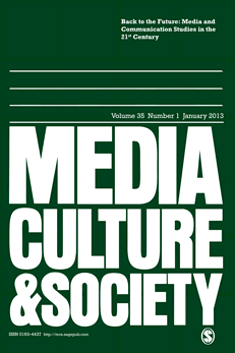
MEDIA CULTURE & SOCIETY
Connecting Researchers Through the Lens of Media and SocietyMEDIA CULTURE & SOCIETY, published by SAGE PUBLICATIONS LTD, is a prominent academic journal dedicated to the interdisciplinary exploration of media, culture, and societal dynamics. With a long-standing history since its inception in 1979 and extending to 2024, this journal serves as a vital platform for researchers, professionals, and students interested in understanding the complex interplay between media and cultural phenomena. Operating from the United Kingdom, it holds a prestigious Q1 ranking in both communication and sociology/political science categories, reflecting its significant impact within these fields. The journal’s Scopus ranks further attest to its excellence, placing it in the top percentiles and making it an essential resource for advancing scholarly discussions. While not open access, MEDIA CULTURE & SOCIETY continues to provide insightful analyses that shape contemporary discourse on the role of media in society, ensuring its relevance and importance to academic communities worldwide.

Dixit
Fostering Dialogue Across DisciplinesDixit is a respected academic journal published by Universidad Católica del Uruguay, Facultad de Ciencias Humanas, primarily focusing on the fields of humanities and social sciences. With an ISSN of 1688-3497 and an E-ISSN of 0797-3691, this journal has been a fully Open Access publication since 2007, enabling free and unrestricted access to its high-quality research. It serves as a vital platform for scholars, researchers, and students to explore innovative ideas and disseminate valuable findings that contribute to the understanding of human experiences across various contexts. The journal's commitment to open access not only promotes knowledge sharing but also facilitates cross-disciplinary dialogue, making it an essential resource for anyone seeking to deepen their insights into the humanities. By fostering collaboration and engaging the academic community, Dixit plays a pivotal role in advancing scholarly discourse in Latin America and beyond.
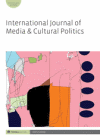
International Journal of Media & Cultural Politics
Charting New Territories in Media ResearchThe International Journal of Media & Cultural Politics, published by INTELLECT LTD, serves as a vital platform for scholarly discourse in the rapidly evolving fields of communication and cultural studies. With an ISSN of 1740-8296 and an E-ISSN of 2040-0918, this journal has established itself as a key resource since its inception in 2009, with significant contributions from 2013 to 2023. It is categorized within the Q3 quartile for Communication and Q2 for Cultural Studies, reflecting its commitment to high-quality research and its influential role in shaping contemporary discourse, evidenced by its Scopus rankings of #322 in Cultural Studies and #289 in Communication. Although not an open access journal, its comprehensive access options and rigorously peer-reviewed articles make it an essential read for researchers, professionals, and students seeking to understand the intricate intersections of media, politics, and culture in today’s society, fostering a deeper engagement with critical issues in these domains.
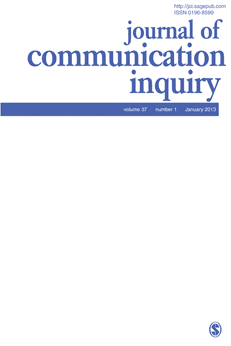
Journal of Communication Inquiry
Elevating Voices in Communication and Cultural DiscourseJournal of Communication Inquiry, published by SAGE PUBLICATIONS INC, is a premier interdisciplinary journal that serves as a vital platform for scholars and practitioners in the fields of communication, cultural studies, and the arts and humanities. With a rich history dating back to its inception in 1974, the journal has consistently upheld rigorous academic standards, reflected in its impressive rankings within the Q1 and Q2 quartiles across various disciplines according to the latest metrics. The journal's comprehensive scope encompasses theoretical and empirical research, catering to a diverse readership who are keen to explore contemporary communication issues and cultural dynamics. While the impact factor is not explicitly stated, the journal's Scopus ranks position it favorably within its categories, with notable percentiles that highlight its influence in the academic community. As an essential resource for researchers, professionals, and students alike, the Journal of Communication Inquiry invites contributions that advance the discourse surrounding communication practices and cultural phenomena, contributing to the ongoing dialogue in these evolving fields.

Comunicacion y Sociedad-Guadalajara
Empowering voices through accessible academic discourse.Comunicacion y Sociedad-Guadalajara is a distinguished peer-reviewed journal published by UNIV GUADALAJARA that plays a vital role in the field of communication studies. With an ISSN of 0188-252X and an E-ISSN of 2448-9042, this journal has embraced Open Access since 2023, ensuring that groundbreaking research is accessible to a wider audience. Hailing from Mexico, it serves as a platform for innovative research and critical discourse in communication, ranking Q2 in the Communication category and securing a notable Scopus rank of #[232/511, positioning it within the top 54th percentile of its field. Covering converged years from 2009 to 2010 and from 2013 to 2024, the journal's objective is to foster scholarly dialogue and advance knowledge across diverse aspects of communication. With a commitment to excellence, Comunicacion y Sociedad-Guadalajara stands as an essential resource for researchers, professionals, and students seeking to engage with contemporary issues in communication.

International Journal of Communication
Bridging theory and practice in communication studies.International Journal of Communication, published by USC Annenberg Press, is a premier open access journal dedicated to advancing the field of communication studies. Since its inception in 2007, the journal has provided a vital platform for researchers, professionals, and students to engage with cutting-edge research, theoretical frameworks, and empirical studies. With an impressive Q1 quartile ranking in Communication for 2023 and a notable Scopus rank of 156 out of 511 in the Social Sciences Communication category, the journal consistently contributes to high-quality scholarly discourse. It covers a wide array of topics, making it a crucial resource for those looking to stay informed about the latest developments in communication research. The journal's commitment to open access enhances its reach and impact, fostering a global community of academics and practitioners dedicated to exploring the complexities of communication in contemporary society. This makes the International Journal of Communication an essential read for anyone interested in understanding the dynamics of communication today.

Nordicom Review
Pioneering Open Access for Cutting-Edge Communication ScholarshipNordicom Review is a preeminent open-access journal published by SCIENDO, dedicated to advancing the field of communication studies. Established in Sweden, it has been at the forefront of disseminating scholarly research since its inception in 2000, providing a platform for innovative ideas and discussions. With an impressive impact factor that reflects its commitment to quality, the journal has achieved a remarkable Q1 rating in the Communication category for 2023, ranking 154 out of 511 in Scopus, placing it in the 69th percentile among peer-reviewed journals. The Nordicom Review embraces a broad scope, covering topics that intersect with media, communication policies, and societal implications, making it indispensable for researchers, professionals, and students alike. This journal supports the dissemination of knowledge and fosters dialogue among scholars, ensuring that crucial developments in communication are accessible globally.